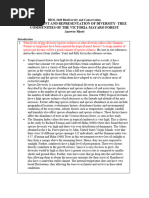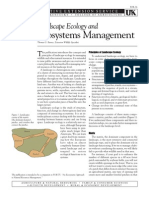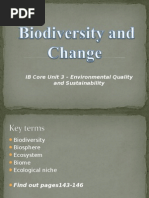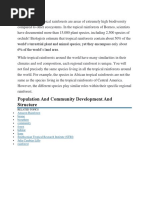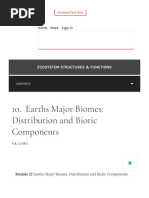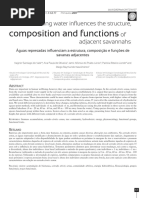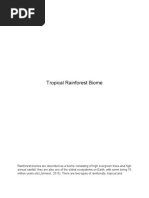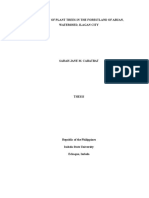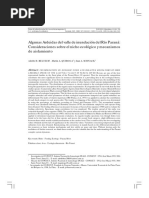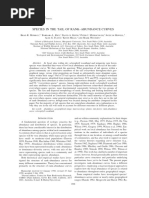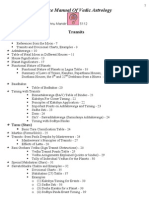Tropical Rainforest and Tropical Grassland
Tropical Rainforest and Tropical Grassland
Uploaded by
Gellie Dela Rosa ValenciaCopyright:
Available Formats
Tropical Rainforest and Tropical Grassland
Tropical Rainforest and Tropical Grassland
Uploaded by
Gellie Dela Rosa ValenciaOriginal Description:
Copyright
Available Formats
Share this document
Did you find this document useful?
Is this content inappropriate?
Copyright:
Available Formats
Tropical Rainforest and Tropical Grassland
Tropical Rainforest and Tropical Grassland
Uploaded by
Gellie Dela Rosa ValenciaCopyright:
Available Formats
ABSTRACT A tropical forest in Mount Makiling, UP Los Banos and tropical grassland in Putinglupa, Calamba were observed.
Species in both biomes were observed and recorded. Species found in tropical rainforest is relatively higher than those found in tropical grassland. There were 27 species found and identified in tropical rainforest while in tropical grassland, there were only 16 species. Logically, it can be stated that the rainforest has higher diversity and evenness of species which is equal to 2.593 and 0.787, respectively. However, when it comes to dominance, the grassland has greater value which is equal to 0.189 thus; its species diversity is low. The dominant species in the tropical rainforest is Palosanto while Imperata cylindrica dominated the grassland. There is no similar species that can be found in both biomes which states that grassland would not be dominated by the species found in the forest. As studied, in tropical regions, there are repetitive disturbances that inhibit succession. Thus, ecological succession is not likely to occur in the type of grassland observed. INTRODUCTION To most ecologists, the term community means an assemblage of species that occur together in the same place. Ecologists also agree that the species living together within a community can interact strongly as consumers and resources or as competitors. Some ecologists have asserted that the community is a unit of ecological organization having recognizable boundaries and whose structure and functioning are regulated by interactions among species. Others have regarded the community as a loose assemblage of those species that can tolerate the conditions of a particular place or habitat, but which has no distinct boundary where one type of community meets another (Ricklefs, 2008). Biomes are major communities of organisms that have a characteristic appearance and that are distributed over a wide land area defined largely by regional variations in climate. There are many ways to classify biomes, and
different ecologists may assign the same community to different biomes (Johnson and Raven, 2002). The tropical rainforest is s hot and moist biome found near the Earths equator. 60 to 10 inches of precipitation which is fairly evenly distributed throughout the year is received by tropical forests. Tropical rainforests become a suitable environment for many plants and animals through the combination of constant warmth and abundant moisture present in it. It also contains the greatest biodiversity in the world having over 15 million species of plants and animals. Grassland biomes, on the other hand, are large open regions on Earth that have a lot of grass hence, the name grassland. Bushes do not grow much in grassland and the trees are commonly found near the rivers. Grasslands make up almost of the Earths land surface. It rains between 10 to 30 inches per year in this region. If there is more rain, trees will grow and the land would become a forest but when there is lee rain, the land would become a desert thus; grasslands are often located between deserts and forests. Communities exist in a state of continuous flux. Organisms die and others are born to take their places; energy and nutrients pass through the community. Yet the appearance and composition of most communities do not change appreciably over time. But when a habitat is disturbed the community slowly rebuilds. Pioneering species adapted to disturbed habitats are successively replaced by other species as the community attains its former structure and composition. The sequence of changes initiated by disturbance is called succession, and the ultimate association of species achieved is called a climax community (Ricklefs, 2008). This study was designed to determine if ecological succession is likely to occur in grassland biome. It also aims to infer stages of ecological succession after the study of grassland and forest communities and describe the structures of tropical grassland communities through measures of species diversity and dominance indeces. This study was conducted at Putinglupa, Calamba and Mount Makiling, UP Los Baos on July and August, 2007.
REVIEW OF RELATED LITERATURE There are studies focusing on species diversity. Samuel M. Scheiner, Stephen B. Cox, Michael Willig, Gary G. Mittelbach, Craig Osenberg and Michael Kaspari conducted a study regarding patterns of species diversity as a scale. It also determines how, for a given set of species, the species-area curve varies with respect to latitude or productivity. Critical is whether the relationship is scaleinvariant (i.e. the speciesarea curves for different levels of the third variable are parallel), rank-invariant (i.e. the curves are non-parallel, but non-crossing within the scales of interest) or neither, in which case the qualitative relationship is scale-dependent. This recognition is critical for the development and testing of theories explaining patterns of species richness because different theories have mechanistic bases at different scales of action. Scale includes four attributes: sample-unit, grain, focus and extent. Focus is newly defined here. Distinguishing among these attributes is a key step in identifying the probable scale(s) at which ecological processes determine patterns (Cox, et al. 2000)
RESULTS AND DISCUSSION Trails in biomes, tropical grassland and rainforest, were made in order to determine the species present. The data gathered were organized in Table 4C.1, 4C.2 and 4C.3. (Insert table 4C.1 to 4C.3 here) Primary forest refers to untouched, pristine forest that exists in its original condition. This forest has been relatively unaffected by human activities. Primary rainforest is often characterized by a full ceiling canopy and usually several layers of understory. The ground floor is generally clear of heavy vegetation because the full canopy allows very little light, necessary for plant growth, to penetrate. Occasionally, when a canopy tree falls, a temporary "light gap" is opened in the canopy, allowing growth of floor and understory species. Primary forest is the most biologically diverse type of forest. Secondary forest is rainforest that has been disturbed in some way, naturally or
unnaturally. Secondary forest can be created in a number of ways, from degraded forest recovering from selective logging, to areas cleared by slash-and-burn agriculture that have been reclaimed by forest. Generally, secondary forest is characterized (depending on its level of degradation) by a less developed canopy structure, smaller trees, and less diversity. Due to the lack of a full canopy, more light will reach the floor, supporting vigorous ground vegetation. "Jungle" is the term often applied to secondary forest with dense ground growth, but it is also applied to some tropical moist forests where seasonal variations permit thick ground growth. Based on the information gathered, a secondary forest community will not replace the grassland community because no type of species that covers up the forest was found in the forest and in most tropical grasslands there are many repeated disturbances like fire or agricultural practices that inhibit ecological succession.
The community with higher diversity, evenness, and degree of dominance were determined (see Table 4C.4). Results showed that tropical rainforest has higher diversity (2.593) and evenness (0.787) as compared to the tropical grassland (1.996 and 0.720, respectively). One property of diversity is that it ensures an even community to have a greater index of diversity than one, in which the community is dominated by one or few of them n which case its diversity in the intuitive sense would be less (Pielou, 1975). However, when it comes to dominance, the tropical grassland has higher value (0.189) than that of rainforest (0.131). The degree of dominance was computed by using the Simpson Index of dominance. It takes a different approach- the number of times we would have to take pairs of individuals at random to find a pair of the same species. Dominants in a community may be the most numerous, possess the highest biomass, preempt the most space, make the largest contribution to energy flow or mineral cycling, or by some other means, control or influence the rest of the community (Smith and Smith, 2006). A community dominated by one or two species is considered to be less diverse than one in which several different species have a similar abundance.
The species, Imperata cylindrica and Mimosa, are found to be common in grassland. Grass is a very successful plant because it can survive the harshest conditions. Unlike most plants, grasses grow from the base, not the top. Creeping stems above the ground are called stolons, and those below the ground are called rhizomes. As these creeping stems spread out, shoots grow up and produce leaves. The deep, spreading root systems make sure that even in drought; the plants are able to get water. Long narrow leaves like grass do not lose as much water in the heat as big leaves do. Grass can be cut quite close to the ground, and new leaves (blades of grass) sprout from the base of the plant. This means that grasses can be eaten and walked on by animals and are not killed. Trees and shrubs have been observed to be rare in tropical grasslands. The variable rainfall is not enough to support large trees but is sufficient for many species of grass (Asis and Velasquez, 1993). Trees, especially Palosanto, and shrubs turned out to be common in forest. In sharp contrast, the climate of the tropical rainforest is hot and wet. With over 80 inches of rain per year, as opposed to the desert's 10 inches or less, plants have adaptations that enable them to shed water efficiently. The leaves of many rainforest plants have drip tips for this purpose. Buttress and stilt roots are thought to provide extra support for trees growing in spongy, wet soils. Tropical rainforest plants also have adaptations to take in what little sunlight is available on the dark forest floor. Large leaves are common; they increase the amount of sunlight a plant can capture. Other plants, like orchids, bromeliads and ferns, grow as epiphytes high up in the canopy where there is more sunlight. SUMMARY AND CONCLUSION To determine if ecological succession is likely to occur in grassland, an experiment was conducted using two types of biomes: the tropical grassland in Putinglupa, Calamba and the tropical rainforest in Mount Makiling, UP Los Baos. A belttransect (10m x 30m) and a line transect (30m) were laid out on the tropical rainforest and tropical grassland, respectively. The species found in these areas
were identified and recorded in tables. There are 27 species in the belt-transect of rainforest while 16 species present in the transect line of the grassland. Using the same data, the indices of diversity were computed and results showed that the rainforest has: H= 2.593, J= 0.787, D= 0.131, SID= 0.869, E= 0.032 while the grassland has: H= 1.996, J= 0.720, D= 0.189, SID= 0.811, E= 0.051. Based on the values computed, the rainforest has the higher diversity of species than the grassland. The Palosanto and shrubs dominates the forest and the Imperata cylindrica and Mimosa dominates the grassland. The species found in the two biomes are completely different. These differences may be due to the distance of the biomes observed. Ecological succession will most likely not occur in grassland because no species in the rainforest will dominate or occur on it. If the study would be changed and choose biomes near to each other, the chances of having same species will increase. As studied, in tropical regions, the grasslands would not exhibit ecological succession because it would be inhibited by repetitive disturbances like agricultural practices or fire. Thus, ecological succession would not occur in grassland. LITERATURE CITED
Ricklefs, R.E. 2008. The Economy of Nature. 6th ed. New York: W. H. Freeman and Company
Asis, C.V. and Velasquez, C.C. 1993. Modern Biology. Revised Ed. Quezon City: Atlas Publishing Company, Inc. Johnson, G.B. and Raven, P.H. 2002. Biology. 6th ed. New York: McGraw-Hill Companies, Inc. Pielou, E.C. 1975. Ecological Diversity. Canada: John Wiley and Sons, Inc. y Scheiner, M.S., et al. 2000. Evolutionary Ecology Research. 2000. Cambridge: Cambridge University Press. Smith, R.L. and T.M. Smith. 2006. Elements of Ecology. 6th Ed. New York: Addison Wesley Longman, Inc. Ehrlich, P. R. and J.Roughgarden. 1987. The Science of Ecology. New York, USA: Macmillan Inc.
Janzen, D. H.1988. Management of Habitat Fragments in a Tropical Dry Forest: Growth. Annals of the Missouri Botanical Garden. USA: Missouri Botanical Garden Press
Bruner, W.E. and Weaver, J.E. 1945. Ecological Monographs: Ecological Society of America. Lincoln, Nebraska, United States: Agronomy and Horticulture Faculty. Accessed February 19 through: http://www.digitalcommons.unl.edu/agronomyfacpub/474/ Begon, M., J.L. Harper and C.R. Townsend. 1998. Ecology: Individuals, Populations and Communities. 2nd Ed. Blackwell Publ., U.S.A.
You might also like
- TRC-6 Sonixs 1650x600 Manual 2018 Rev ADocument296 pagesTRC-6 Sonixs 1650x600 Manual 2018 Rev Agoretty cantonNo ratings yet
- 11 BIOL3468 - Measurement - and - Representation - of - Diversity - Ans - Sheet 2021Document6 pages11 BIOL3468 - Measurement - and - Representation - of - Diversity - Ans - Sheet 2021maahru.cakesNo ratings yet
- 1 MPB-501 - Application For Pension 2 MPC - 60Document10 pages1 MPB-501 - Application For Pension 2 MPC - 60Anitha Mary DambaleNo ratings yet
- Ecosystems Management: Landscape Ecology andDocument8 pagesEcosystems Management: Landscape Ecology andOpenBar BiofestNo ratings yet
- Global Mental Health Action PlanDocument22 pagesGlobal Mental Health Action PlanJenezon CardenioNo ratings yet
- Principles of EntrepreneurshipDocument108 pagesPrinciples of EntrepreneurshipKemba Semper100% (1)
- Ecology CycleDocument30 pagesEcology CycleNiko Jay RojasNo ratings yet
- The Living World Revision BookletDocument15 pagesThe Living World Revision Bookletayyanasad939No ratings yet
- Ecosystem DiversityDocument12 pagesEcosystem DiversitynilkanthretailenterpriseltdNo ratings yet
- Community Density and StabilityDocument33 pagesCommunity Density and StabilityhongrangjoshNo ratings yet
- Species Abundance and Diversity: Tridentata Across Sonoran Desert Landscapes by Differences inDocument2 pagesSpecies Abundance and Diversity: Tridentata Across Sonoran Desert Landscapes by Differences inumbuNo ratings yet
- Final Module EnviSciDocument55 pagesFinal Module EnviSciJeff Ray BarreraNo ratings yet
- Forest EcosystemDocument21 pagesForest Ecosystemsunny_live0992% (12)
- Review of Related LiteratureDocument12 pagesReview of Related LiteratureEllaNatividad0% (1)
- EcosystemDocument9 pagesEcosystemJiyansh VussonjiNo ratings yet
- TREES - Bill MollisonDocument14 pagesTREES - Bill MollisonAlana BaileyNo ratings yet
- 7.biodiversity and Forest BiodiversityDocument6 pages7.biodiversity and Forest Biodiversitytunazina.rhythmaNo ratings yet
- FINALS Forest Ecology - 104240Document14 pagesFINALS Forest Ecology - 104240artleebuteng134No ratings yet
- Philatics PrimatesDocument12 pagesPhilatics PrimatesjokercorvoNo ratings yet
- J Vegetation Science - 2012 - Wilson - Plant Species Richness The World RecordsDocument7 pagesJ Vegetation Science - 2012 - Wilson - Plant Species Richness The World RecordsAhmad AlawiNo ratings yet
- Tropical Rainforest, Also Spelled Tropical Rain ForestDocument13 pagesTropical Rainforest, Also Spelled Tropical Rain ForestHaseeb KhâñNo ratings yet
- DeforestationDocument4 pagesDeforestationRoscela Mae D. ArizoNo ratings yet
- Clássico Importante 1972 The Tropical Rain ForestDocument8 pagesClássico Importante 1972 The Tropical Rain ForestClaudio SantanaNo ratings yet
- s41586-023-06820-zDocument25 pagess41586-023-06820-zfabi.iara.jarroNo ratings yet
- Forest EcosystemDocument12 pagesForest EcosystemAlysa Shereen Alba FerrierNo ratings yet
- Biodiversity and ChangeDocument55 pagesBiodiversity and Changeapi-241480872No ratings yet
- Ecosystem and Biomes and Energy FlowDocument12 pagesEcosystem and Biomes and Energy FlowKathleen Joy SarabosingNo ratings yet
- World Ecology and Climate ChangeDocument7 pagesWorld Ecology and Climate Changemocit51855No ratings yet
- Population and Community Development and StructureDocument45 pagesPopulation and Community Development and StructureXernick Marquez FelipeNo ratings yet
- Bahasa Inggris GeografiDocument11 pagesBahasa Inggris GeografiElia RizkiaNo ratings yet
- Diversity of Living Creatures in Tropical Forest EcosystemsDocument12 pagesDiversity of Living Creatures in Tropical Forest EcosystemsPatrick AlexanderNo ratings yet
- Impact of Sloths on N Eotropical ForestDocument30 pagesImpact of Sloths on N Eotropical Forestjaime.lozanoNo ratings yet
- Environmental Science Cambil JR Ronald S. Activity FridaDocument4 pagesEnvironmental Science Cambil JR Ronald S. Activity FridaRonald Cambil Jr.No ratings yet
- LEC 4 - Community EcologyDocument10 pagesLEC 4 - Community EcologyaulinepaulNo ratings yet
- Forest Our LifelineDocument9 pagesForest Our LifelineVrinda TayadeNo ratings yet
- Community EcologyDocument4 pagesCommunity EcologyBiju ThomasNo ratings yet
- Earths Major Biomes- Distribution and Biotic Components – Ecosystem Structures &Document23 pagesEarths Major Biomes- Distribution and Biotic Components – Ecosystem Structures &likekeke3No ratings yet
- ODocument4 pagesOFahmidaNo ratings yet
- Species DiversityDocument5 pagesSpecies Diversitykp kc100% (2)
- ForestDocument40 pagesForesttanbir singhNo ratings yet
- Composition and Functions: Damming Water Influences The Structure, of Adjacent SavannahsDocument15 pagesComposition and Functions: Damming Water Influences The Structure, of Adjacent SavannahsVanesa Jaramillo RodriguezNo ratings yet
- Plant Communities of Western Amazonia: Bot. Rev. (2009) 75:271 - 291 DOI 10.1007/s12229-009-9032-1Document21 pagesPlant Communities of Western Amazonia: Bot. Rev. (2009) 75:271 - 291 DOI 10.1007/s12229-009-9032-1sandra hernandezNo ratings yet
- Biogeography NotesDocument58 pagesBiogeography NotesDakarirayi MutenherwaNo ratings yet
- Types of Biomes - CompiledDocument7 pagesTypes of Biomes - CompiledToni GutzNo ratings yet
- Diversity of Lfe UwiDocument2 pagesDiversity of Lfe UwiTyler EdwardsNo ratings yet
- UNIT-2 ECOSYSTEMDocument20 pagesUNIT-2 ECOSYSTEMsukrampal285No ratings yet
- Tropical Rainforest BiomeDocument5 pagesTropical Rainforest BiomeGimme Your WafflesNo ratings yet
- ThesisDocument14 pagesThesischerry m cabatbatNo ratings yet
- Ecosystem ExplainedDocument6 pagesEcosystem ExplainedGlorylourd Joana FulloNo ratings yet
- Genetic Effects of Rainforest Fragmentation in An Early Successional Tree (Elaeocarpus Grandis)Document9 pagesGenetic Effects of Rainforest Fragmentation in An Early Successional Tree (Elaeocarpus Grandis)secrettasteuhhNo ratings yet
- BiodiversityDocument25 pagesBiodiversityOrane CassanovaNo ratings yet
- President Ramon Magsaysay State University: Chapter 2. The Evolution of EcosystemsDocument6 pagesPresident Ramon Magsaysay State University: Chapter 2. The Evolution of EcosystemsKipi Waruku BinisutiNo ratings yet
- RainforestDocument12 pagesRainforesthenriquepotNo ratings yet
- Rai Rainforest SCIDocument7 pagesRai Rainforest SCIRomeo GiotNo ratings yet
- Beltzer Et Al - Algunas Ardeidas Del Valle de Inundación Del Río ParanáDocument28 pagesBeltzer Et Al - Algunas Ardeidas Del Valle de Inundación Del Río ParanáAlejandra ArreolaNo ratings yet
- STF1023 LU1a BasicConceptofEcology 18.9.18 PDFDocument42 pagesSTF1023 LU1a BasicConceptofEcology 18.9.18 PDFPriya TharusiniNo ratings yet
- Ecology of Life: Group 1 Bayrante, Angelo Cañeso, Francia F. Foliente, Erish Paul Ponciano, Jovelt Sahurda, Christine BDocument12 pagesEcology of Life: Group 1 Bayrante, Angelo Cañeso, Francia F. Foliente, Erish Paul Ponciano, Jovelt Sahurda, Christine BPaul VallegaNo ratings yet
- 7th Science Calamity 3Document10 pages7th Science Calamity 3gc canisNo ratings yet
- Laguna State Polytechnic University: College of EngineeringDocument26 pagesLaguna State Polytechnic University: College of EngineeringJirah LacbayNo ratings yet
- Bio Diversity MidDocument4 pagesBio Diversity MidHabiba Rowshan (221011069)No ratings yet
- 0012 9658290803asittor3b2Document11 pages0012 9658290803asittor3b2Elias RuizNo ratings yet
- Daftar Saldo Awal Persediaan BarangDocument92 pagesDaftar Saldo Awal Persediaan BarangTheBlackJenny TBJNo ratings yet
- Vinyl Chloride MonomerDocument6 pagesVinyl Chloride MonomerRizqia Putri ZakkaNo ratings yet
- Overcoming Limiting Mind Sets To Improve Safety VFDocument5 pagesOvercoming Limiting Mind Sets To Improve Safety VFDavid NazarethNo ratings yet
- GCP Paper Group 7Document82 pagesGCP Paper Group 7Janella JinksonNo ratings yet
- Solution JeeDocument28 pagesSolution Jeesinghswayam32No ratings yet
- Mandatory CSR - A Trap or Requirement PDFDocument12 pagesMandatory CSR - A Trap or Requirement PDFAnirban KarNo ratings yet
- Disaster Managment Uttarkhand Landslides SST HHW by Anagha Shanil 9FDocument9 pagesDisaster Managment Uttarkhand Landslides SST HHW by Anagha Shanil 9FANAGHA SHANILNo ratings yet
- Class 3 RecruitmentDocument27 pagesClass 3 Recruitmentsaurabh CHATURVEDINo ratings yet
- Case Study On Marketing StrategyDocument4 pagesCase Study On Marketing StrategykainatNo ratings yet
- Psychosocial Activities Junior High SchoolDocument29 pagesPsychosocial Activities Junior High SchoolRosarie CharishNo ratings yet
- English Language - Level V Week 10 - Class 1: Revision - Mock Mid-Term ExamsDocument51 pagesEnglish Language - Level V Week 10 - Class 1: Revision - Mock Mid-Term ExamsMiloš MićkoNo ratings yet
- Tawi TawiDocument2 pagesTawi TawiAiyana PolesticoNo ratings yet
- 2.9.40 Uniformity of Dosage Units PDFDocument4 pages2.9.40 Uniformity of Dosage Units PDFefra maneNo ratings yet
- DIN 11851 Coupling: EN 10357-D (INCHES, SMS, BS)Document15 pagesDIN 11851 Coupling: EN 10357-D (INCHES, SMS, BS)zmatij24No ratings yet
- Feed Your Brain, Lose Your Belly A Brain Surgeon Reveals The Weight-Loss Secrets of The Brain-Belly Conne PDFDocument147 pagesFeed Your Brain, Lose Your Belly A Brain Surgeon Reveals The Weight-Loss Secrets of The Brain-Belly Conne PDFBineke100% (5)
- Vouk Hotel Suites Company ProfileDocument40 pagesVouk Hotel Suites Company ProfileMyLife 4SuccessNo ratings yet
- Performance Task For Disaster Readiness and Risk Reduction 1st SemDocument3 pagesPerformance Task For Disaster Readiness and Risk Reduction 1st SemAngelyn Lingatong100% (1)
- NSTPDocument24 pagesNSTPtabiNo ratings yet
- Case Study Ryanair - EditedDocument7 pagesCase Study Ryanair - EditedpmthogoNo ratings yet
- ARI Standard 210 240Document124 pagesARI Standard 210 240rag2604756437No ratings yet
- Reference Manual of Vedic AstrologyDocument259 pagesReference Manual of Vedic AstrologyJohn Ricco100% (1)
- PH Eur 2 17 White Paper 1647878165Document11 pagesPH Eur 2 17 White Paper 1647878165Ellie SenoNo ratings yet
- Live Below The Line: Meals and Menus For Under 1 Per DayDocument27 pagesLive Below The Line: Meals and Menus For Under 1 Per DayrectorrhagiaNo ratings yet
- Admin,+3739 4437 1 CEDocument11 pagesAdmin,+3739 4437 1 CEangelbustos822No ratings yet
- New Resume Letter-CvDocument3 pagesNew Resume Letter-CvMartin KariisaNo ratings yet
- Too Vs EnoughDocument3 pagesToo Vs EnoughFifiNo ratings yet

